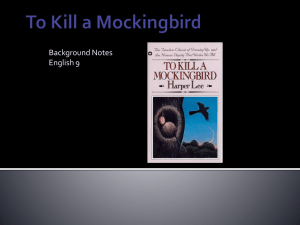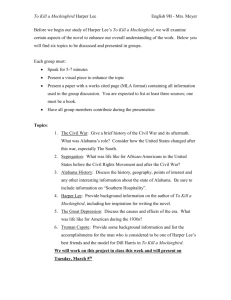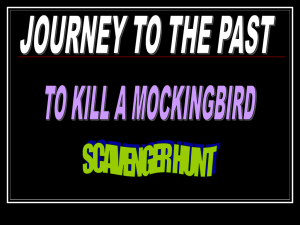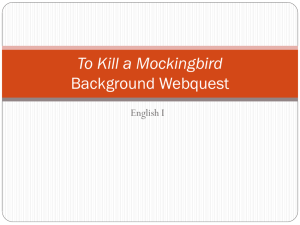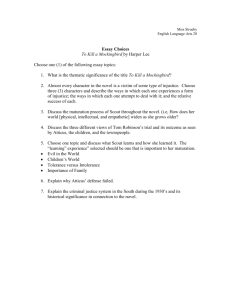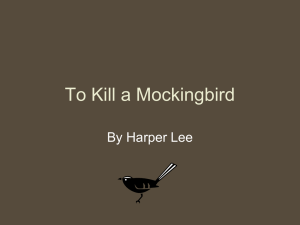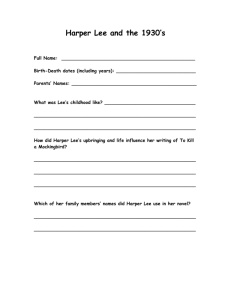To Kill a Mockingbird
advertisement
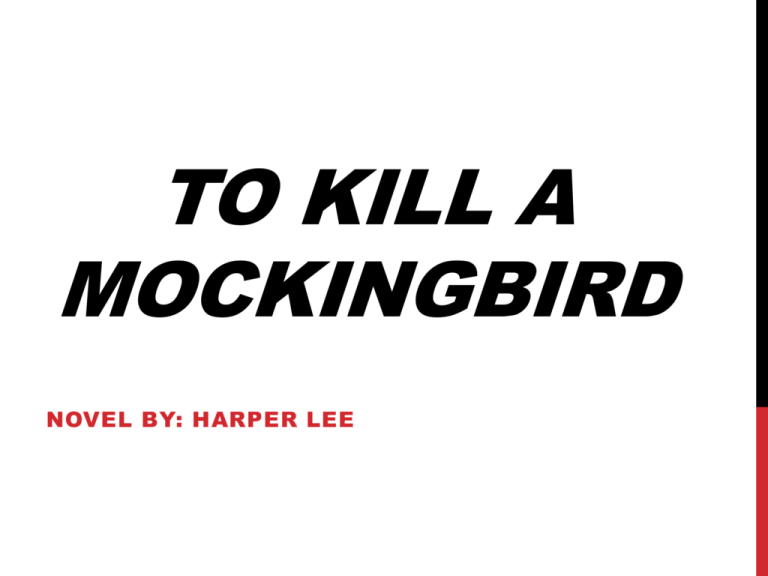
TO KILL A MOCKINGBIRD NOVEL BY: HARPER LEE (NELLE) HARPER LEE • Born in Monroeville, Alabama on April 28, 1926 (she would have been same age as Scout, the narrator, when the book takes place) • Lee’s father was a small-town lawyer • Her father’s side of the family is related to Robert E. Lee (Confederate general) • Lee spent many hours of her childhood at the local courthouse with her father • Lee’s mother’s maiden name was Frances Finch • Harper Lee attended the University of Alabama where she studied law, but she did not finish her degree because she moved to New York. • Harper Lee published To Kill a Mockingbird in 1960 and it remains the only novel she ever published. • She wrote To Kill a Mockingbird as a first-person narrative from Scout’s perspective. TO KILL A MOCKINGBIRD • Book was published in 1960, which was a time of great civil unrest in America. Novel quickly rose to the top of every bestseller list and stayed there for over 18 months. There were 15 million copies of the book sold in the first couple years of publication. • Lee won the Pulitzer Prize for Literature in 1961 • Scout, who is the narrator, is 5 years old (almost 6) when the book begins and Jem, her brother, is 9 (almost 10). The book is told from Scout’s childhood point of view as a flashback and covers a period of about 3 years. • Many believe the trial in the story (Part II) is based on the “Scottsboro Boys” trial that occurred in April 1931. This case showed the lack of equal justice and strong prejudice in the South. “SCOTTSBORO BOYS” TRIAL • Nine African-American teenage boys (the youngest was 12) were accused and put on trial for raping two young white women on a train. • All-white jury convicted all of the African-American boys and sentenced some to 75-99 years in prison and others to the death penalty. • The US Supreme Court overturned the verdicts twice and the case was retried in Alabama (once because of inadequate counsel for the defendants and once because the trial did not have any African-American members on the jury). • There were six appellate trials and later one of the women recanted her testimony. In 1937 the charges were dropped for 5 of the men, two were paroled in 1944, one was paroled in 1951, and one was pardoned in 1976. • Lee was only 6 during this trial, but it had a profound impact on her and there are many similarities to this trial that can be found in the novel. SOUTHERN SOCIAL STRUCTURE IN EARLY 1900S • After the Civil War ended, the social structure of the South changed. Social class played a major role in Southern culture. (Social class and race are very important in To Kill a Mockingbird.) • Plantation owners and educated professionals made up the upper class. (Many lived on same plantations or in same towns for generations. Family name meant a lot to social standing and reputation.) • Small farm and small business owners made up the middle class. • African-American farmers, mill workers, and unskilled laborers made up the lower class. • However, in the 1930s the South suffered greatly due to The Great Depression. Farm prices fell over 50% in value. • Average family income in early 1930s was $750 annually, but annual farm income was only $275. RACISM IN THE SOUTH IN 1930S • Most significant social issues in the South in the 1930s were segregation and poverty. • Laws forbid African-Americans and whites from mixing in any public areas such as schools, restrooms, buses, or trains. • Mixed marriage was not allowed • African-Americans had separate schools, but most “colored” schools did not have books or supplies, and the children had little opportunity to attend school because they were needed to work the fields. • African-Americans and farmers suffered the most financially in the South during the 1930s. VOTER REQUIREMENTS IN THE SOUTH DURING 1930S • 15th amendment was ratified on February 3, 1870, which gave African-Americans the legal right to vote. • Many Southern states manipulated this law by having strict voter registration requirements such as: • Literacy tests (many could not read) • Poll taxes (many could not afford the tax) • Making voting locations difficult to find (unclear location) • Intimidation of voters (fear of physical harm) CONTROVERSY AND TO KILL A MOCKINGBIRD • The Civil Rights movement was a major focus and issue across the nation when the book was published. • Critics often claim the book is unrealistic because it is told from a child’s perspective. • Others favor the novel and claim it is an accurate portrayal of racist discrimination in the South during the 1930s. • The book is still banned in some schools because of derogatory language and instances of violence. • Advocates of the novel claim it teaches tolerance and an understanding of the importance of race equality, which is still a social issue in today’s society. THEMES IN THE NOVEL … • Deceptive appearances • Loss of innocence • Reality of evil in the world • Prejudice • Courage and Bravery CHARACTERS IN THE NOVEL (LIST ON YOUR MWDS) … Scout (Jean Louise Finch) Boo (Arthur) Radley Jem (Jeremy Finch) Uncle Jack Atticus Finch Mrs. Dubose Aunt Alexandra Miss Caroline Dill Cousin F. Finch Miss Maudie Rev. Sykes Calpurnia Judge Taylor Heck Tate (sheriff) Mr. Gilmer Miss Rachel Mr. Nathan Radley Tom Robinson Helen Robinson Mayella Ewell Mr. Walter Cunningham Mr. Bob Ewell Walter Cunningham (Jr.) Miss Stephanie Crawford Miss Merriweather Dolphus Raymond Mr. BB Underwood Mr. Link Deas Cecil Jacobs
